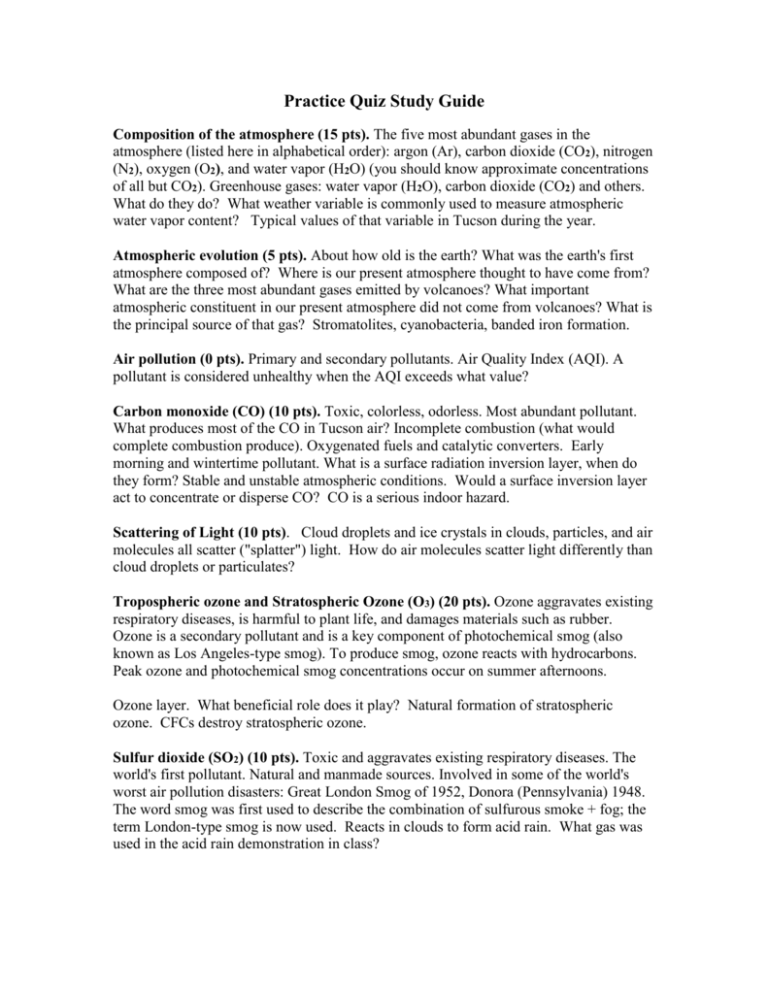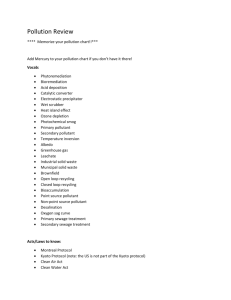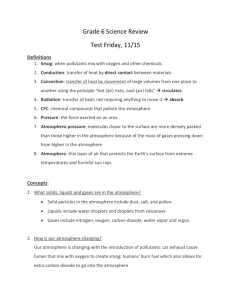Practice Quiz Study Guide
advertisement

Practice Quiz Study Guide Composition of the atmosphere (15 pts). The five most abundant gases in the atmosphere (listed here in alphabetical order): argon (Ar), carbon dioxide (CO2), nitrogen (N2), oxygen (O2), and water vapor (H2O) (you should know approximate concentrations of all but CO2). Greenhouse gases: water vapor (H2O), carbon dioxide (CO2) and others. What do they do? What weather variable is commonly used to measure atmospheric water vapor content? Typical values of that variable in Tucson during the year. Atmospheric evolution (5 pts). About how old is the earth? What was the earth's first atmosphere composed of? Where is our present atmosphere thought to have come from? What are the three most abundant gases emitted by volcanoes? What important atmospheric constituent in our present atmosphere did not come from volcanoes? What is the principal source of that gas? Stromatolites, cyanobacteria, banded iron formation. Air pollution (0 pts). Primary and secondary pollutants. Air Quality Index (AQI). A pollutant is considered unhealthy when the AQI exceeds what value? Carbon monoxide (CO) (10 pts). Toxic, colorless, odorless. Most abundant pollutant. What produces most of the CO in Tucson air? Incomplete combustion (what would complete combustion produce). Oxygenated fuels and catalytic converters. Early morning and wintertime pollutant. What is a surface radiation inversion layer, when do they form? Stable and unstable atmospheric conditions. Would a surface inversion layer act to concentrate or disperse CO? CO is a serious indoor hazard. Scattering of Light (10 pts). Cloud droplets and ice crystals in clouds, particles, and air molecules all scatter ("splatter") light. How do air molecules scatter light differently than cloud droplets or particulates? Tropospheric ozone and Stratospheric Ozone (O3) (20 pts). Ozone aggravates existing respiratory diseases, is harmful to plant life, and damages materials such as rubber. Ozone is a secondary pollutant and is a key component of photochemical smog (also known as Los Angeles-type smog). To produce smog, ozone reacts with hydrocarbons. Peak ozone and photochemical smog concentrations occur on summer afternoons. Ozone layer. What beneficial role does it play? Natural formation of stratospheric ozone. CFCs destroy stratospheric ozone. Sulfur dioxide (SO2) (10 pts). Toxic and aggravates existing respiratory diseases. The world's first pollutant. Natural and manmade sources. Involved in some of the world's worst air pollution disasters: Great London Smog of 1952, Donora (Pennsylvania) 1948. The word smog was first used to describe the combination of sulfurous smoke + fog; the term London-type smog is now used. Reacts in clouds to form acid rain. What gas was used in the acid rain demonstration in class? Particulate Matter (PM) (5 pts). Small particles (generally less than 10 micrometers) that are inhaled into the lungs and sometimes enter the bloodstream. Sources of PM. PM is a health concern and also affects visiblity. How are PM and gaseous pollutants most effectively removed from the atmosphere? Sample questions (from the Fall 2000 quiz packet) Practice Quiz: 1, 3, 4-7, 9, 12, 13, 16a, 20, EC1 Quiz #1: 1, 2, 4a 20(2nd part) Final Exam: 2, Mass, weight, density, and pressure. This material has been moved to the Quiz 1 Study Guide. Reviews Mon., Sep. 17 4 - 5 pm Haury (Anthropology) 216 Tue., Sep. 18 Tue., Sep. 18 2 - 2:50 pm 4 - 5 pm Saguaro Hall 225 Haury (Anthropology) 129 Wed., Sep. 19 4 - 5 pm Harvill 204 The Mon review is nominally for the MWF class, the W review is for the T Th class.






